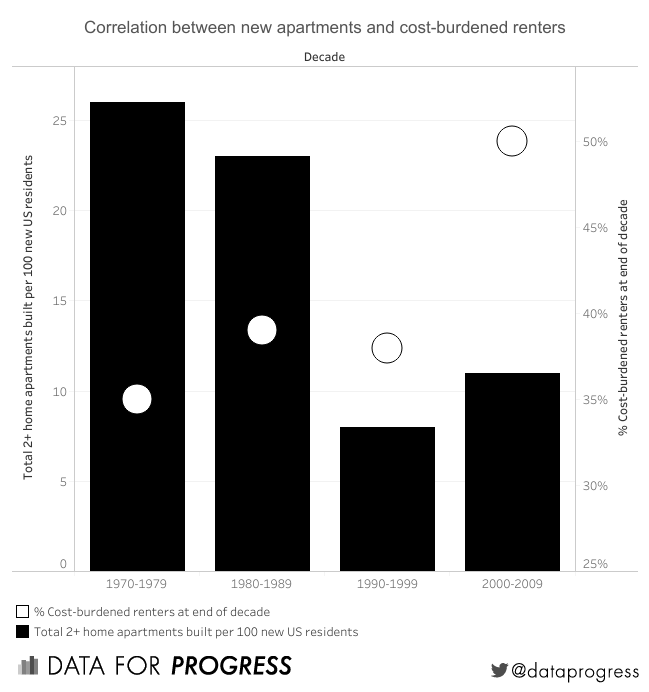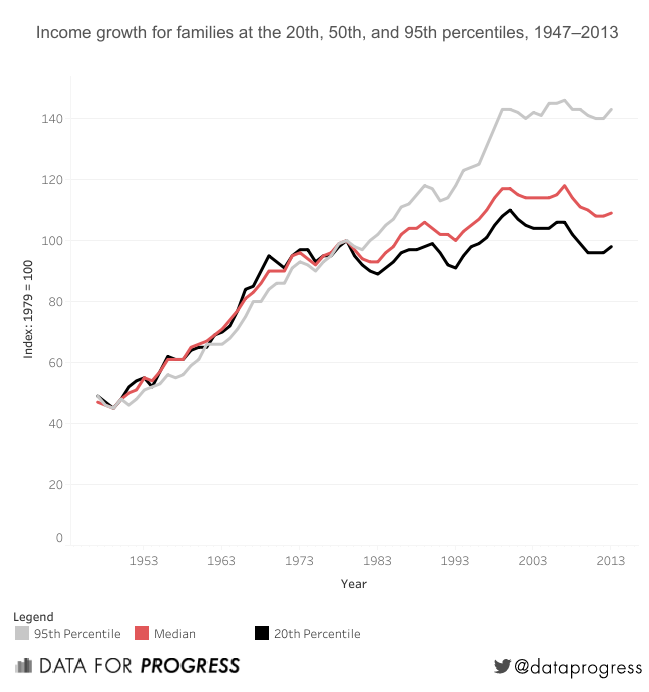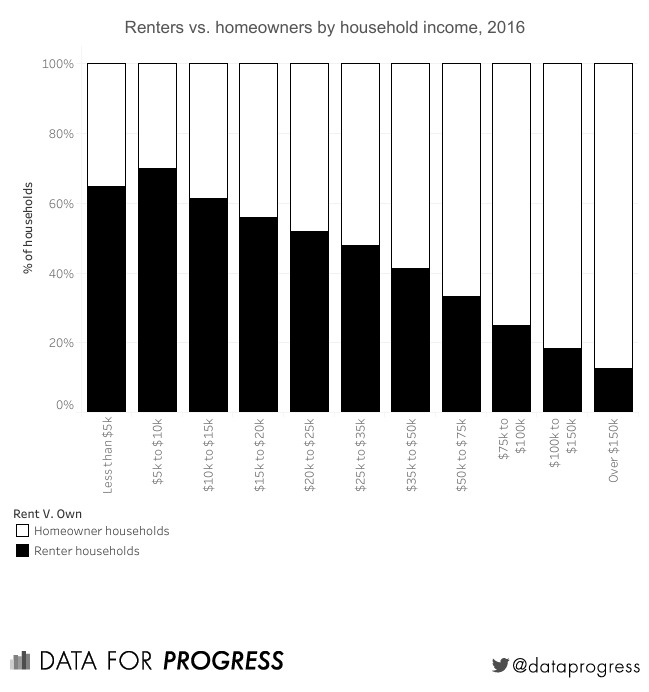The Case for Ending Apartment Bans
Laura Loe Bernstein (@sharethecities) and Henry Kraemer (@HenryKraemer)
There’s a stubborn disagreement right now over the roots of America’s housing crisis, and whether runaway rents can be eased by ending apartment bans. We can all see that rising rents have far outpaced wages, just one of the many ways crony capitalism squeezes the working class, poor folks, communities of color, and the shrinking middle class. Millions of Americans need the housing crisis to end, and for the United States to establish housing as a human right. This crisis was born of a willful, elite effort to exclude the masses from decent neighborhoods by banning the apartments we can afford. The crisis cannot end without undoing that sin.
We need a Housing Guarantee in this country, to ensure that everybody has a home they can afford, and can rest easy knowing they will never be priced out of it. That means:
Robust social housing options accessible to all people.
The ability for people to choose to opt-out of our broken for-profit housing systems and into a federally supported system that favors limited equity co-ops, community land trusts, and a massive investment in public social housing yet unseen in the United States (but common in Europe).
Year-to-year rent stabilization and presumption of indefinite tenure to give renters peace of mind that their landlords won’t spike their rents or no-cause evict them.
Cash assistance or solidarity funds to help people who need it to pay their rent.
Ending apartment bans to stop perpetuating the race and class separation that resulted from past land use wrongs.
Successfully enacting these first four priorities is nearly or entirely impossible if we do not end apartment bans. Also known as exclusionary zoning, apartment bans restrict new home-building to the sort of single-family houses most commonly associated with suburbs and affluent neighborhoods. Apartment bans are extraordinarily widespread, and render it illegal to build duplexes, triplexes, fourplexes, and other spaces where multiple families can live nestled together (and often more cheaply) on the same plot of land. These bans have been central to the widespread disparities in access to the best parks, transit, scenic views and amenities, while consigning the lower classes to underfunded schools, environmental racism and generational wealth gaps.
Without a housing guarantee that opens the door to every neighborhood, we cannot build geographically equitable social housing, therefore new development will continue to segregate our communities by class and race.
Legalizing apartments in every community in the United States will not be enough. We need strong rental regulations to protect residents of these new apartments from exploitation and harm from their landlords. We need universally accessible public housing options to give renters the freedom to ditch their landlords if they want. But that starts with making space for apartments, especially in the neighborhoods wealthy property owners have long hoarded for themselves.
Without abolishing apartment bans we are left with very little space in growing cities to place social housing. Let’s say we raise taxes on the rich as much as we dream, and set about to build social housing apartments. Right now, apartments – market rate or not – are illegal in much of the useable land in American cities (only 17% of Seattle’s buildable land allows apartments, for instance). Where will we put the new social housing if apartment bans remain? (And it will take years to build the social housing we need; in the meantime let’s at least build some places for middle class and working class people to live.)
Too few policymakers who care about working people, too few homes built for working people.
Numerous studies, as well as lived experience, point to a massive housing shortage in America. Experts estimate we are roughly 7 million rental homes short of what is needed to house everybody affordably from coast to coast (though clearly regional economic disparities have led some cities to have rows of vacant houses while many others are home to ever-growing homeless camps). In that context, with millions of Americans fighting over scraps, landlords can charge tenants whatever they want. This power imbalance leads to desperate economic and mental health outcomes. Nearly half of renters are paying over 30% of their incomes for shelter - including well over half of Black and Latinx renters.
As with every economic ill afflicting US residents, this did not just happen. It is the fault of intentional government disinvestment and segregation at all levels, targeted to pad the comforts of a privileged few at the expense of the basic needs of the many.
It begins, like most problems in America, with white supremacy. Even if you set aside that all of the land in question was stolen from Native Americans, throughout our national history, land use has focused on excluding people of color.
In 1917, the Supreme Court struck down city ordinances that explicitly banned Black people from certain neighborhoods. In response, then-Commerce Secretary Herbert Hoover convened a committee (largely comprised of segregationists) who invented modern exclusionary zoning, allowing neighborhoods to ban apartments and plexes. By keeping their neighborhoods off-limits to anyone who could not afford a full plot of land on their own, white wealthier folks were able to legally exclude the vast majority of Black families (as well as working class whites) from their neighborhoods. Just as the federal government explicitly pushed single-family zoning to prevent a socialist revolution, they pushed apartment bans to keep the classes separate. This birthed the invisibly gated communities that are still with us today.
Not only did Herbert Hoover foster the runaway capitalism that brought us the Great Depression, but he brought us the apartment bans that continue to keep working people out of livable neighborhoods around the country.
In the context of de facto segregation, apartments were consigned to poor inner cities. But at least housing was still being built. After World War II, white veterans got cheap loans to move to the suburbs, and new, segregated housing projects went up for black veterans and their families to rent. It was not until the mid 1970s when construction began to dip, as Nixon declared a moratorium on new public housing projects, and governments at all levels turned against all homes that did not fit the white suburban ideal. Since then, even as the US population has grown, we have fallen further and further behind the need for new homes, and the share of cost-burdened renters doubled.
This happens to roughly coincide with when widespread prosperity in America ended and rampant income inequality began. Broad-based income growth ended in the mid 1970s, just as investment in building apartments did.
Ending Apartment Bans Can Unite The Progressive Movement
Organization names are for identification purposes only.
"As socialists we believe that housing is a universal human right. Exclusionary zoning has prevented many folks, mostly low-income communities and communities of color, from securing stable housing while prioritizing the needs of wealthy homeowners. It is time for that to end, and ending apartment bans is an important step in the right direction toward equitable, affordable housing for all." - Keaton Slansky, former co-chair, Seattle DSA
“Our housing justice campaign is comprised of 15 power organizations across the country and a base of over 10,000 grassroots leaders who are directly impacted by housing injustice. We have re-committed to a national housing justice campaign in the past year and begun building the infrastructure necessary to win. Recently we ratified a strategy to win a homes guarantee. Ending apartment bans is a central component of a strategy to de-commodify housing and ensure that it is treated as a human right and public good.” - Tara Raghuveer, People’s Action
"I support this initiative whole heartedly. The Neighborhood Action Coalition has worked to directly support and advocate for houseless neighbors in Seattle as housing rates have risen dramatically. Bans on density building prevent progress on low-income housing that is needed to create long term solutions and prevent more people from being displaced and ending up out of doors." - Kaya Axelsson of the Seattle Neighborhood Action Coalition
"We can’t hope to reverse course on climate change or build an equitable future without massively expanding affordable housing in cities around the country. As middle- and low-income people are pushed out of urban centers to areas without reliable access to public transit, uprooted from their communities and forced to commute long distances, they pay with their time and their health and we all suffer from sprawl, congestion, and carbon pollution. The time for action is now. Expanding affordable housing stock will require a range of policy changes: progressive funding for public and non-profit housing; investment in co-operative and community-controlled housing; and opening up urban space to apartments and other forms of multi-unit housing. The choices local governments make today will shape our cities for decades to come." - Katie Wilson of the Transit Riders Union
"Asian Americans are America's fastest growing demographic and now have the largest income inequality. For many in our community, this is painfully felt in housing affordability. The American Dream means different things to different communities, but at its heart it's about families having a safe stable place to live. This means having an array of housing options, including more apartments complexes that allow for communities to thrive. " - Duncan Hwang, associate director of the Asian Pacific American Network of Oregon

Modern American income inequality was not started by a disinvestment in plexes and apartments. However, the same set of policy instincts that led politicians to undermine unions, cut taxes for the rich, and invest in corporations over people also led them to disinvest in apartments and other community-oriented housing. Politicians’ priorities shifted from lifting up working people to aiding the already privileged and comfortable, and housing for the masses was a casualty.
Instead of building more homes, the government chose to subsidize wealthy homeowners. That has led to the median homeowner being 46 times wealthier than the median renter, and home sizes nearly tripling in the last 80 years.

Building more apartments helps the middle class & working class
To end an affordable housing crisis built over decades, we need to do many things that attack the roots of crony capitalism, but one is unquestionably the abolition of apartment bans. But this inspires a lot of eye rolling and mumbles of “but why should we do anything that helps developers?” when we mention this to our comrades.
So long as capitalism survives, developers and landlords will find a way to reap a profit. We need to beat capitalism and build a new world, and in the process we need to force developers to play by our rules, shifting the landlord-tenant balance of power back to the people. As social justice focused urbanists, we recognize the market was designed to fail to meet people’s needs. So we advocate to refashion the housing market on our own terms, forcing the market to build the homes we need while fighting tooth and nail for companion policies that will ensure equitable outcomes.
People living on the brink of homelessness or foregoing medical needs to pay rent cannot wait for capitalism to fall before we bring rents down. This is a crisis. We are in no position to turn away solutions. It is immoral to respond to this emergency by blocking or delaying new housing.
While some claim that new apartments are driving inequality, they are wrong. If anything, the opposite is true. Recently these skeptics have begun citing a Washington Post story from August 6th that showed the wave of new apartment construction has led to rents dropping for the top ⅓ of renters, leveling off for the middle ⅓ of renters, and rising for the bottom ⅓ of renters. Assuming that analysis is accurate, we should examine who precisely comprises each of those groups of renters and what the impact is on inequality if rents fall for any of them. You may be surprised.
Even the richest renters are not very rich. The richest one-third of renter households (whose dropping rents are cited by new housing skeptics as a social ill) make ~$50,000 or more per year. Seventy of them make less than $100,000 per year. They are, by definition, middle class; and middle class rents going down will always be good news. We want school teachers to be able to live in the same city as their students. Nurses working 12-hour shifts shouldn’t need to need to travel an hour or more to and from an urban hospital. Housing prices shouldn’t keep loving couples from starting families (as is happening today).
A household making over $150,000 per year is seven times more likely to be a homeowner than a renter; those wealthy homeowners’ housing payments are both more stable and subsidized by the U.S. government. Rents going down for the not-very-wealthy wealthiest ⅓ of renters doesn’t increase inequality versus the ownership class; it lowers it.
The middle one-third of renter households make between $20,000-$50,000 per year. That puts them anywhere between near-poverty and middle class. Their rents stabilizing is great news but doesn't receive sufficient attention in the Washington Post article.

Rents going up for the poorest ⅓ of renters is terrible news and points to deep structural problems with our current housing system. Many capitalists and policymakers stand to blame for that, but among them are those who stopped building apartments. In the 1990s and 2000s, we built one new apartment unit for every 11 new American residents. Compare that to one new apartment for every 4 new Americans in the 1970s, and you can see how much the government’s abandonment of renters drove the current crisis.
Renter cost-burdens spiked in the late 2000s, when the subprime mortgage crisis threw millions of foreclosed homeowners into a rental market with far too few places to live. Politicians set bad policy, and the market failed to solve the problem on its own. The market will never be able to solve the whole problem, and the current exclusionary policy regime is making it impossible to solve any of it. We need to change the rules.
A lot of questions remain: Can housing be affordable and also a nest egg? How might younger activists incorporate the unique needs of elders in their work? How can this work by mostly white and white-passing urbanists make space for the work of indigenous communities towards land reparations? How can we incorporate green building standards and reduce reliance on cars to address dangerous climate change? How will we muster the political will to raise the trillions of dollars it will take to build the social housing we need during a particularly oppressive national political regime?
We will all continue to have a lot of questions. But we can solve one. We can tear down the invisible walls that keep the masses out of livable neighborhoods. We must do that.
Myra Lara, one of the best intersectional queer POC urbanist leftist cartoonist activists in Seattle summarized our frustration:
“If you won't increase wages, support progressive taxation, end the police state, improve public schools, and provide affordable healthcare, at least let us fucking live in your neighborhood Deborah.”
-----
Authors:
Henry Kraemer (@HenryKraemer) is a third-generation socialist activist, organizer, and writer living in Portland, OR. He spent the last ten years advocating for voting rights and youth political power, including spearheading the creation of America’s first automatic voter registration law and its expansion across the country. Turning his attention to the built environment, he is currently working in renewable energy and fighting to end exclusionary zoning in Portland and beyond.
Laura Loe Bernstein (@sharethecities) is a DSA-curious housing practivist and part-time bus driver in Seattle, WA. She founded Share The Cites as a response to zoning injustice, pressure on natural places, and climate change. Their efforts are focused on studying the best use for a public golf course in a transit-rich part of Seattle with low displacement risk.
